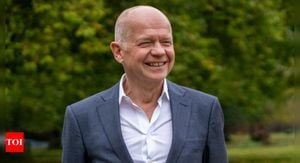NASA is on the verge of making a pivotal decision about the return of astronauts Butch Wilmore and Suni Williams, who have now been aboard the International Space Station (ISS) for over two months. Originally launched aboard Boeing's Starliner spacecraft, their mission, intended to last just over a week, has faced extensive delays due to significant technical issues with the spacecraft.
While the astronauts were supposed to conduct routine operations and return to Earth shortly after launch, complications arose during the Starliner’s approach to the ISS. Notably, five of the spacecraft's thrusters malfunctioned, hampering timely docking and leading to unforeseen delays.
Problems didn't stop there; the spacecraft was also plagued by a helium leak from its propulsion system, which was initially thought to be minor. These setbacks have kept Wilmore and Williams operating on the ISS far longer than planned, merging their roles of scientific research with ISS maintenance tasks.
Despite being trained for such unexpected situations, the lengthening mission brings about various logistical challenges for NASA. Now, the agency is weighing options on how to safely return the astronauts without compromising the integrity of operations aboard the ISS.
NASA officials expect to finalize their approach by the end of August, with two primary options under consideration. One strategy involves sending Wilmore and Williams back aboard the Starliner, albeit with its troubled history, requiring careful evaluation of the spacecraft's readiness for the impending return.
Alternatively, NASA may choose to utilize SpaceX's Dragon capsule for their return. This would necessitate changes to the upcoming Crew-9 mission, which is currently scheduled to launch with four astronauts—potentially reducing their number to accommodate Wilmore and Williams.
Should NASA decide to go with the Dragon capsule, it could delay the astronauts’ return until February 2025. This choice might also result in the Starliner returning to the ground without any crew, negatively impacting Boeing’s quest for certification of the spacecraft.
The urgency of the situation has not gone unnoticed, as Ken Bowersox, NASA's associate administrator for space operations, emphasized the need for prompt action. "We’re reaching a point where, the last week of August, we really should be making a call, if not sooner," Bowersox stated, underscoring the multifaceted effects this decision could have on the ISS and its operational schedule.
Meanwhile, both astronauts have kept busy, contributing to scientific experiments and maintenance aboard the ISS during their extended stay. Joe Acaba, chief of the astronaut office at NASA’s Johnson Space Center, noted they have been kept informed of the decision-making process, reinforcing their importance to the mission and to NASA's agenda.
The upcoming weeks are set to be decisive as NASA navigates the challenges of engineering, safety, and operational management. The agency continues to monitor the situation closely, ensuring the well-being of the astronauts remains at the forefront of their plans.
While Boeing continues to express confidence about Starliner’s capabilities, hesitation lingers over the spacecraft's readiness following its tumultuous launch. Boeing officials have gone on record stating expectations were not managed effectively from the start, with Starliner program manager Mark Nappi reflecting on their oversight, stating, "I think we all knew it was going to go longer than we had originally planned.



